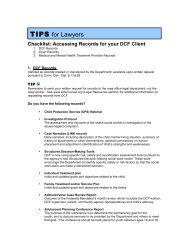Making Court the Last Resort - Center for Children's Advocacy
Making Court the Last Resort - Center for Children's Advocacy
Making Court the Last Resort - Center for Children's Advocacy
You also want an ePaper? Increase the reach of your titles
YUMPU automatically turns print PDFs into web optimized ePapers that Google loves.
helps to develop a service plan in which Family Keys has up to three weeks to connect<strong>the</strong> family to useful services. In some cases, this is sufficient to resolve <strong>the</strong> problems thatled <strong>the</strong> family to seek help. If not, a family may be referred to longer-term <strong>the</strong>rapeuticprograms in <strong>the</strong> community.Between March 2003 and March 2008, Family Keys received 2,375 referrals. Of <strong>the</strong>2,180 families who accepted Family Keys’ services, 98 percent, or 2,136 children, avoidedout-of-home placement. In 2007, <strong>the</strong> program served 396 families, with an operatingbudget of approximately $422,000. The average program duration that year, from referralto discharge, was 22 days.County leaders have been pleased with Family Keys and <strong>the</strong> collaborativeconversations that have flourished since its inception. Victoria Casey, probationcommissioner <strong>for</strong> Orange County, praises Family Keys as a significant change from <strong>the</strong>previous system, which was less helpful to kids and families. “We now invest in <strong>the</strong>mand have an entire continuum of services that only begins with Family Keys,” she says.Dave Jolly, commissioner of <strong>the</strong> county’s Department of Social Services, agrees.“The immediate crisis intervention is best equipped to mitigate family conflicts,” he says.“It’s user-friendly, client-friendly, and leads to better outcomes <strong>for</strong> youth and families.”Orange County’s status offender re<strong>for</strong>ms were at <strong>the</strong> <strong>for</strong>efront of a larger movementacross New York State. Effective April 1, 2005, New York’s Family <strong>Court</strong> Act wasImmediate Response to RunawaysFamily Keys was expanded in 2005 to provide a tailored response in runawayPINS cases. Since 2005, Family Keys has been meeting runaway youth and <strong>the</strong>irfamilies at probation immediately after <strong>the</strong>y have been brought in by <strong>the</strong> sheriff’sdepartment. Using <strong>the</strong> crisis intervention model described above, program staffwork with <strong>the</strong> family to develop a responsive service plan and <strong>the</strong>n presentthis plan to a judge in <strong>the</strong> presence of <strong>the</strong> youth’s parents at <strong>the</strong> initial courtappearance. In 2007, Family Keys served 57 runaways; all of <strong>the</strong>se young peopleavoided residential placement.7
















